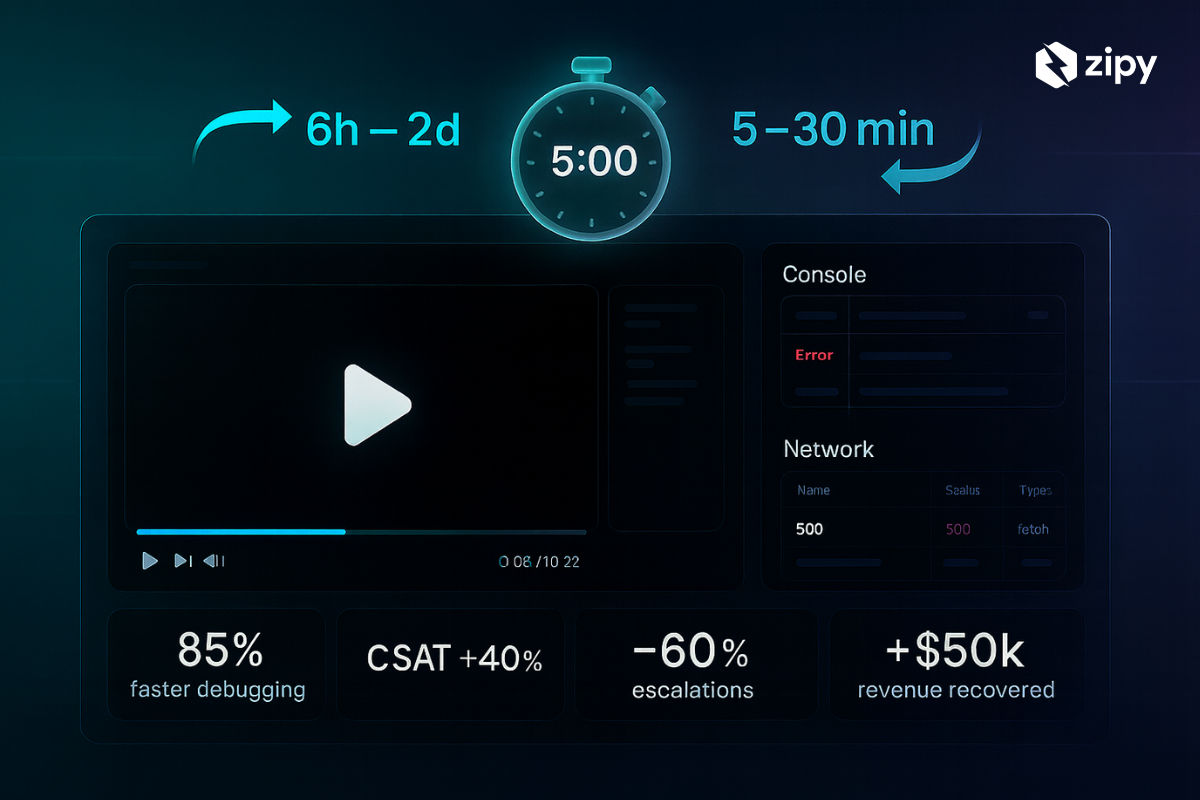Introduction
When it comes to iOS app development with Swift, encountering errors is inevitable. One such error that often perplexes developers is the NSInternalInconsistencyException. In this article, we'll delve into what this exception means, explore scenarios where it might occur, and provide practical solutions to handle it effectively.
Catch errors proactively with Zipy. Sign up for free!
Try Zipy now
Scenario 1
Error code
func fetchData() {
guard let data = fetchDataFromServer() else {
fatalError("Data fetch unsuccessful")
}
// Process fetched data
}
Corrected code
func fetchData() {
guard let data = fetchDataFromServer() else {
// Handle nil data gracefully
fatalError("Data fetch unsuccessful: Missing data")
}
// Process fetched data
}
Solution Summary
In this scenario, the error occurs when the fetchDataFromServer() function returns nil, leading to a fatal error due to unwrapping an optional without proper handling. By adding a check for nil data and providing a descriptive error message, we prevent the app from crashing unexpectedly.
Scenario 2
Error code
func processUserInput(_ userInput: String?) {
guard let input = userInput else {
fatalError("Invalid user input")
}
// Process user input
}
Corrected code
func processUserInput(_ userInput: String?) {
guard let input = userInput else {
// Handle nil input gracefully
fatalError("Invalid user input: Input is nil")
}
// Process user input
}
Solution Summary
Here, the error arises when attempting to process user input that is nil, leading to a fatal error. By incorporating a check for nil input and providing a clear error message, we enhance the app's robustness and prevent unexpected crashes.
Scenario 3
Error code
func calculateResult() -> Int {
guard let value = performComplexCalculation() else {
fatalError("Calculation error")
}
return value
}
Corrected code
func calculateResult() -> Int {
guard let value = performComplexCalculation() else {
// Handle calculation failure
fatalError("Calculation error: Result is nil")
}
return value
}
Solution Summary
In this scenario, the error occurs when a complex calculation returns nil, leading to a fatal error during result processing. By explicitly handling the nil case and providing an informative error message, we ensure smoother execution of the app.
Handling NSInternalInconsistencyException in Swift
To effectively handle NSInternalInconsistencyException in Swift, it's crucial to adopt defensive programming practices and incorporate error handling mechanisms such as guard statements and optional unwrapping. By identifying potential points of failure and implementing robust error handling, developers can minimize the occurrence of such exceptions and enhance the stability of their iOS apps.
Proactive Error Debugging with Zipy
Conclusively, dealing with runtime errors like NSInternalInconsistencyException demands a proactive approach to debugging. Tools like Zipy offer invaluable assistance by enabling developers to monitor errors in real-time and replay user sessions for comprehensive analysis. By leveraging proactive error monitoring and session replay capabilities provided by Zipy, developers can identify and resolve issues swiftly, ensuring a seamless user experience.
Debug and fix code errors with Zipy Error Monitoring.
Sign up for free
Conclusion
In this article, we've explored the nuances of handling NSInternalInconsistencyException in Swift, providing insightful scenarios, code examples, and solutions to mitigate this error effectively. By embracing best practices in error handling and leveraging advanced debugging tools like Zipy, developers can elevate the quality and reliability of their iOS applications.
Resources on how to debug and fix Swift errors
- 12 Swift errors you should know: Swift exception handling with code examples
- Swift error handling for iOS Developers | Zipy AI
- How to handle Swift UnexpectedlyFoundNilError?
- How to handle Swift ArrayIndexOutOfBoundsException?
- How to handle Swift TypeMismatchError?
- How to handle Swift ArrayOutOfBoundsError?
- How to handle Swift UnexpectedlyFoundNilWhileUnwrappingAnOptional?
- How to handle Swift InvalidCastException?
- How to handle Swift NSInvalidArgumentException?
- How to handle Swift NSRangeException?
- How to handle Swift FatalError?
- How to handle Swift EXC_BAD_ACCESS?
- How to handle Swift NSUnknownKeyException?
Frequently Asked Questions
Q: What is NSInternalInconsistencyException in Swift?
A: NSInternalInconsistencyException is a runtime exception that occurs when an internal inconsistency is detected in the application's state or behavior.
Q: How can I fix NSInternalInconsistencyException in Swift?
A: To fix NSInternalInconsistencyException, ensure robust error handling mechanisms are in place, such as guard statements, optional unwrapping, and defensive programming practices.
Q: What are the common causes of NSInternalInconsistencyException?
A: Common causes of NSInternalInconsistencyException include unexpected nil values, improper state transitions, and inconsistencies in data processing.
Q: Is it possible to prevent NSInternalInconsistencyException entirely?
A: While it's challenging to completely eliminate NSInternalInconsistencyException, diligent error handling, thorough testing, and proactive debugging can significantly reduce its occurrence.
Q: How can Zipy help in debugging NSInternalInconsistencyException?
A: Zipy provides proactive error monitoring and session replay capabilities, allowing developers to identify, diagnose, and resolve NSInternalInconsistencyException and other runtime errors efficiently.
Key takeaways
- Proper error handling techniques such as guard statements and optional unwrapping are essential for mitigating NSInternalInconsistencyException.
- Descriptive error messages help in identifying and resolving issues more effectively.
- Proactive debugging tools like Zipy offer invaluable assistance in monitoring and resolving runtime errors in Swift applications.
- Prioritizing robustness and reliability in app development minimizes the impact of NSInternalInconsistencyException and enhances the overall user experience.
.svg)






.png)




.webp)